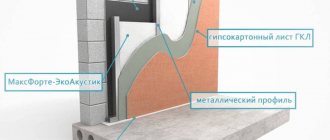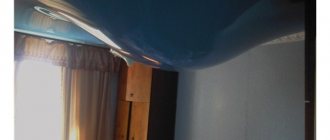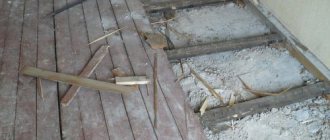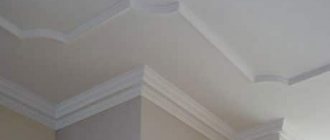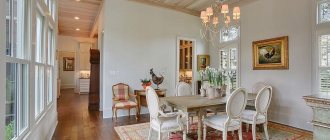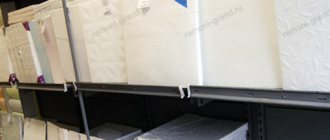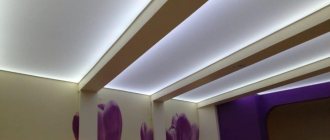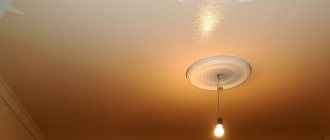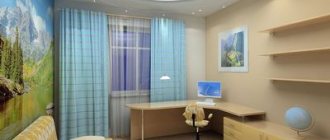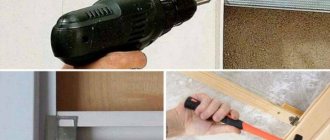From this article you will learn:
- What is the difference between frameless soundproofing of the ceiling in an apartment and sound absorption?
- What is frameless soundproofing of the ceiling in an apartment?
- What materials are used for frameless soundproofing of the ceiling in an apartment?
- How to install frameless soundproofing of the ceiling in an apartment with your own hands
Living in an apartment building in Moscow, many are faced with the need to soundproof walls, floors and ceilings. When choosing an apartment, many factors can be taken into account, but no one is safe from noisy neighbors. And if the family living above has a small child, soundproofing the ceiling is simply vital.
Properly performed sound insulation will help make your home quiet and comfortable; in addition, modern sound insulation of ceilings can not only fulfill its main purpose, but also decorate the interior of your apartment.
In this article we will look at one of the options for combating noise - frameless soundproofing of the ceiling in an apartment.
What is the difference between frameless soundproofing of the ceiling in an apartment and sound absorption?
Traditionally, people tend to confuse the concept of sound insulation and sound absorption. Meanwhile, these are completely different phenomena and processes, although they give a similar result.
The main difference between sound insulation is the absorption of external sounds, the source of which is located outside the room. Sound absorption is designed to reduce the power of sound waves arising in the internal volume of the room. Therefore, to achieve these, in principle, different goals, appropriate materials and technologies are used.
If the goal is to reduce sound from neighbors or from the street, then high-quality sound insulation is necessary. If it is necessary to reduce the noise occurring indoors, sound-absorbing materials are installed.
Cork sound insulation
Today, manufacturers offer a fairly wide selection of modern materials that provide impeccable sound insulation, including ceiling sound insulation with cork. This natural material is distinguished by its porous structure and unique molecular structure.
Thanks to innovative technologies, an incredible variety of modern equipment and environmentally friendly materials, specialists create unique soundproofing systems. However, such work is carried out not only by qualified specialists, but also by ordinary home owners. It’s better to do cheap soundproofing of the ceiling in an apartment with your own hands, saving a significant portion of money.
When dealing with sound insulation, you should still listen to the advice of qualified craftsmen who recommend installing special ceiling panels. Thanks to their unique properties, not only external sounds are absorbed, but also noise generated inside the rooms. Based on this, we can conclude that you can isolate your home from extraneous noise on your own.
What is frameless soundproofing of the ceiling in an apartment?
Most often, frameless sound insulation is installed together with suspended ceilings, sometimes the widespread plasterboard serves as the finishing layer covering the sound insulation layers.
When using a stretch ceiling, a sound wave arriving from the outside travels the distance between the ceiling slab and the stretch ceiling, is reflected from the surface and returns to the surface of the slab again. This is repeated several times, creating a drum effect. Sound insulation in this case allows you to fill the space between the floor slab and the suspended ceiling. It absorbs incoming sound vibrations and prevents their reflection from surfaces. It is worth noting that this type of sound insulation is effective against airborne, quiet noise, but will not help against sharp, impactful sound.
A standard frameless sound insulation system in an apartment consists of the following elements:
- soundproofing material, which can be of membrane type, or also consist of special slabs and panels;
- adhesive material;
- disc-type dowel-nails;
- fabric that is stretched between the floor slab and the decorative stretch ceiling.
The thickness of the soundproofing material in this case can vary from 1.4 to 4 cm. And the additional noise absorption index with such a sound insulation design can reach a value of 7-9 dB.
According to professionals, the suspended ceiling itself dampens about 5 dB of sound. The technology, thanks to which suspended ceilings are attached not to the floor slab, but to the walls of the room, also contributes to sound insulation - noise is not transmitted directly from the slab to the stretched material. In addition, any suspended ceiling is installed with an air gap, which also insulates the room from noise coming from outside.
When using a suspended ceiling, there is also an air space between the floor slab and the plasterboard, but the fastening system is such that the profile transmits sound from the floor slab to the plasterboard layer. Therefore, the soundproofing properties of a stretch ceiling are still significantly higher than those of a suspended ceiling.
For many people, the soundproofing properties of a standard stretch ceiling will still not be enough, and here it is important not to make a mistake and choose the most suitable material that will act as a soundproofing layer between the floor slab and the stretch ceiling.
The soundproofing characteristics of the ceiling will directly depend on the thickness of the selected material. Although modern materials with a relatively small thickness have excellent soundproofing characteristics, therefore losses in the height of the rooms will be minimal.
The second version of a frameless soundproofing system for ceilings in an apartment is also used:
- special sandwich panels with special vibration-isolating fastening units for the ZIPS system;
- vibration-isolating gasket;
- sealing element;
- special fasteners;
- a layer of drywall specially attached to soundproofing panels.
The use of a design using ZIPS additionally soundproofs the room by 11-18 dB, while the insulation thickness varies between 5.5-13.3 cm.
Designs of noise-proof coatings for ceiling bases
How to soundproof a ceiling largely depends on the condition of its surface, more precisely, on its evenness and the choice of leveling method.
If the ceiling does not need leveling, or a decision has been made to level it using plastic mixtures, then after completion of this work a frameless installation of the soundproofing coating is performed.
If it is decided to level the ceiling using plasterboard, then a soundproofing layer is placed between the lintels of the frame on which the gypsum board is mounted. Such a sound insulation device is a related operation and, with the same leveling method, is called a frame one.
Sometimes a frame structure is also used on flat ceilings - when the thickness of the layer of soundproofing material and, accordingly, its weight is significant, or a combination of several types of insulators is used.
Frame method of soundproofing ceilings
There are many ways to perform sound insulation using frames. They differ in the materials of the frame, its design and location in the insulating shell.
First of all, it is necessary to decide on the choice of insulating materials and the sequence of their layers for noise protection.
It is advisable to mount a sound-absorbing shell (5 cm thick) on the load-bearing base of the ceiling, on top of which noise-reflecting material will be installed on the frame.
Suspensions are mounted on the base according to the markings. We have ready-made brackets for sale, so-called vibration suspensions, which have a porous gasket that dampens vibration.
If mineral wool is chosen as the internal filler, then it is fixed to the ceiling, placed on hangers - the sheets are installed end-to-end. After filling the entire base area with the insulator, the CD-profiles of the frame are mounted to the suspensions and UD-profiles. Thus, the mineral wool is securely fixed to the ceiling with a frame, on top of which two more layers are installed - plasterboard sheets and gypsum fiber, which will act as a sound-reflecting coating.
Finishing is performed on top of the installed sound insulation.
Frameless sound insulation of ceilings
This method requires a flat surface of the concrete ceiling base, since the insulating material, when attached to the ceiling, will repeat its profile. In addition, when using material planting on adhesive mixtures, a maximum contact area and a strong base are required to ensure good adhesion.
The range of soundproofing materials offered by manufacturers today that can be used in a frameless manner is very wide. These include self-adhesive roll and sheet materials and sound-absorbing membranes. But it should be borne in mind that the more advanced the technology, the more financial costs it will require. Let's consider one of the methods of frameless noise protection that does not require significant investment.
Doing your own ceiling soundproofing using the frameless method is technically easier than using a base. Let's consider a variation of the method described above with fastening the sound insulator with plastic disc-shaped dowels.
A sheet of mineral wool or expanded polystyrene is placed on the dried, primed surface and the locations of the holes for drilling are marked with scriber punctures in the corners. The mat is removed and holes of such a diameter are drilled according to the marks on the ceiling so that the fungus enters there without a gap.
Then the element is covered with a layer of glue, applied to the place and temporarily secured with fungi, slightly wedging them with baited anchors so that the sheet is pressed to the base. In this way, all soundproofing mats are attached to the ceiling.
After a day, the attached anchors are removed, the fungi are pulled out, and a fine-mesh (2x2; 3x3 mm) reinforcing steel mesh is attached to the mineral wool shell, piercing it with fungi in the places of the holes drilled in the ceiling and finally driving in the anchors - as a result, the head of the plastic disc dowel should press the mesh with the insulator to the ceiling.
The mesh is primed with a latex-based composition, and after drying, using a wide spatula, the ceiling is plastered layer-by-layer with leveling mixtures - two layers with a cement-based composition, one layer with gypsum finishing putty. After the mixtures have dried, the ceilings are painted using a spray gun.
We choose the level of frameless sound insulation of the ceiling in the apartment and understand the types of noise
Some factors that directly affect the effectiveness of the ceiling soundproofing system in an apartment:
- Type of soundproofing material. Each material has different soundproofing properties and characteristics.
- The thickness of the layer of soundproofing material. For standard materials, the rule works - the thicker the layer, the higher the sound insulation. Although modern materials with a relatively small thickness have high sound insulating properties.
- Number of layers and material of each layer. Practice shows that sound insulation consisting of several layers of different materials gives the best results.
- Type of final coating.
If soundproofing is carried out in an apartment with high ceilings, then you can choose any modern soundproofing material, or better yet, a combination of materials. In such structures, a combination of roll material with gypsum plasterboard and gypsum fiber boards is usually used. The ceiling will lose 7.5-12 centimeters in height.
If the room has relatively low ceilings, then multi-layer sound insulation made from modern materials under a suspended ceiling is suitable. The loss of height will be an average of 3 centimeters, and a maximum of 6 centimeters.
Two types of noise can enter a room from the outside: airborne and impact.
Airborne noise is created by neighbors talking, a crying child, pets, the operation of a vacuum cleaner, etc. Impact noise is generated by mechanical impact on the floor of the apartment above. This could be stomping, dropping an object on the floor, moving furniture.
A special conversation about panel houses. In them, sounds from neighbors are transmitted not only through the ceilings, but also through wall panels and supporting structures of the house. Therefore, in a panel house, the partitions separating the room from the neighbors are also soundproofed.
In brick houses, the sound insulation of wall material is much higher, so if the house is brick, only the ceiling of the apartment will need to be soundproofed.
Partitions in monolithic frame houses are thinner than ceilings, so in such houses sound insulation is required first of all for the walls, and only then for the ceiling.
What does soundproofing work depend on?
Soundproofing of walls and ceilings in an apartment will depend not only on the nature of the noise.
The choice of materials can also be influenced by factors such as its intensity and duration, as well as the presence of finishing on the ceiling surface. Remember! Some finishing materials can contribute to even stronger propagation of sounds, so ideally it is better to do sound insulation “from scratch”, getting rid of unnecessary coatings.
Another factor influencing the complexity and completeness of sound insulation is the nature of the building structure . So, sound insulation in apartments of panel houses must be comprehensive, that is, you cannot get by with just finishing the ceiling. This is due to the similar massiveness of the walls and ceilings in such structures.
If you plan to isolate an apartment in a brick house from noise, it will be enough to carry out work on only one type of surface: the walls here are thicker, and the ceilings have less mass, so they propagate sound worse.
In monolithic houses, the floors between floors, on the contrary, have more weight compared to partitions and external walls. Such houses are built on the basis of hollow bricks and foam concrete, which do not absorb sound.
During the construction of such buildings, the height of the partitions does not reach the height of the floor itself by about 2 centimeters, and sealing and noise-absorbing materials are laid in the formed cavity.
Regardless of what kind of house you live in, you can soundproof the ceiling with your own hands. Therefore, let's talk about the main stages of such work.
Find out what percentage of air humidity is considered normal in an apartment and what instruments can be used to measure it. Read about how to choose a storage water heater for your home in this article: the main varieties are discussed and the selection criteria are indicated.
What materials are frameless soundproofing of the ceiling in an apartment made from?
Today, there are various sound-absorbing and sound-reflecting materials on the market; let’s take a closer look at the main ones:
Plates "Stopzvuk"
Membrane-type soundproofing material. This material has a small thickness, only 2.5-14 mm. Due to its structure, this material does not absorb, but reflects sound. But this material has one significant drawback - high cost.
Recommended articles on this topic:
- Arrangement of a small apartment
- Stages of renovation in an apartment
- Turnkey cosmetic repairs
Roll material Tecsound
It is a soundproofing panel consisting of several layers of different materials. Due to their massiveness and multi-layered nature, they perfectly reduce both ordinary noise and shock waves. In its structure, this material contains various particles, for example, “EcoZvukoIzol” from SoundGuard is made of seven-layer cardboard filled with quartz sand particles. The use of free particles allows increasing the sound absorption of the material.
Panels
One of the varieties of ZIPS panels. This sound insulation consists of gypsum fiber and mineral wool. SoundGuard panels are mounted using special fasteners and are equipped with vibration units. After installation, the panels are covered with plasterboard.
Sandwich panel ZIPS
The so-called "Penoplex". Initially, the material was developed as a heat-insulating material, but during testing it showed excellent sound-proofing qualities. The material is relatively inexpensive and easy to install. However, when choosing, you should take into account one of its properties - it perfectly damps impact noise, but copes worse with ordinary acoustic noise.
Styrofoam
The material, familiar to everyone, is cheap, but ineffective as a soundproofing material. In addition, when burning, polystyrene foam releases harmful substances, including very toxic styrene. Are the financial savings worth the risks?
Cork material
Environmentally friendly, natural material. It has good sound insulation characteristics, but it is worth remembering that for effective sound insulation one layer of cork material of 1 cm will not be enough.
Today there is a great variety of soundproofing materials on the market; it is impossible to list all their types within the scope of this article. It is worth saying that in addition to those mentioned above, coconut fibers, liquid glass, polyurethane foam and other modern materials are used as soundproofing materials.
Ceiling soundproofing materials
99% of the effectiveness of eliminating noise depends on the choice of material. In order to more reliably understand the principle of operation of the entire system, it is necessary to define and distinguish between two concepts. Materials can be sound-absorbing and sound-proofing.
The sound-absorbing material has a fibrous, porous, soft structure. First, braking occurs, and then complete absorption of the sound wave. The fiber from which they are composed provides the desired result with its properties. These include mineral wool, basalt slabs, felt and padding polyester slabs.
Three-layer sound-absorbing and sound-insulating material MaxForte based on fiberglass
Soundproofing is the opposite of the previous type in terms of its operating principle. Such material does not absorb, but reflects sound. It must be dense and strong in its structure in order to reflect the wave, and it would not be able to swing it. These include brick, concrete, etc.
The sandwich construction, with a sound-absorbing material inside and surrounded by massive sound-proofing material on the outside, is the most advantageous in practice. This composite structure will significantly affect the noise reduction ratio. Sound absorption generally depends on the correct choice of material, its thickness and quality. The modern market offers both a lot of long-known and well-proven products, and many new ones that are just beginning to receive reviews: cork, membrane.
Combined soundproofing membrane with a layer of acoustic felt
Mineral wool is a proven method of sound insulation under a suspended ceiling
Mineral wool is first on the list of soundproofing materials. It should be noted that its use will give not only this effect, but also other advantages:
- good insulation;
- ease of installation;
- relatively inexpensive price.
The above qualities are very important at the material selection stage. If we talk about installing soundproofing of the ceiling in an apartment with your own hands, then you will need to construct a wooden frame. The release form of the insulating coating is a roll or mat. Their width determines the range of distances at which each rail is located from each other. In order for the cotton wool to stay firmly on the ceiling, it must fit tightly and with tension under the slats. Therefore, the distance between them should be less than the width of the sound insulator. To ensure against its fall, experts sometimes practice nailing the insulation over its area.
Mineral wool is an environmentally friendly material with good sound-absorbing properties
The downside to the technical characteristics of mineral wool is its instability to moisture, under the influence of which it swells and loses its shape. The way out of the situation was to use the following materials in the following sequence: waterproofing film, mineral wool, vapor barrier.
To protect fibrous sound-absorbing materials from moisture, during their installation they are additionally equipped with hydro- and vapor barriers
Expanded polystyrene: pros and cons of its use for suspended ceilings with sound insulation
High-quality sound insulation can be achieved using a material such as polystyrene foam. It is easy to use, has low thermal conductivity and vapor permeability. The technological process of its manufacture involves saturating polystyrene balls with gas, as a result of which they increase in volume by 50 times or more. This increase gives a high coefficient of elasticity, resistance to compression and lightness. Convenience during installation is ensured by its production in the form of slabs, the thickness of which is from 2 to 10 cm. The noise absorption of polystyrene foam also has a high level: from 23 to 25 dB. Fastening of polystyrene foam boards to the surface of the interfloor ceiling is carried out using special glue, “liquid nails”, and polyurethane foam. For a stronger grip, “fungi” fasteners are used.
Installation of polystyrene foam on the ceiling is carried out using special glue
Do-it-yourself frameless soundproofing of the ceiling in an apartment
When installing frameless soundproofing of the ceiling in an apartment, you must have a certain set of tools and consumables:
- “mushroom-plug” fastening;
- roulette;
- adhesive material;
- building level;
- soundproofing material.
The installation algorithm for frameless ceiling sound insulation in an apartment is as follows:
- Cleaning the ceiling surface, applying primer to it and waiting for it to dry.
- The glue is applied along the edges and center of the panel; there is no need to coat the entire area; work begins by gluing the panel in the corner of the room. The following panels are glued as closely as possible to each other.
- After securing all the panels, we begin installing the fungi, placing them in the center and in the corners - from 2 to 5 fungi for each individual panel.
- We install a classic stretch ceiling - fabric or the more common film.
- If it is impossible to use materials with a large thickness, in order not to lose the height of the ceiling, you can use modern composite materials as sound insulation. They are very expensive, but they provide up to 24 dB of sound absorption, while they are thin, which will allow you not to lose vital space in rooms with low ceilings. Such material will take only 1.2-2.4 cm in height.
Modern materials
Perforated fabric perfectly dampens sound waves. An important condition for its use is the ceiling height, which must be at least 3 meters.
You can install a different design that provides perfect insulation. It combines acoustic thin ceiling insulation with sound-absorbing mineral wool placed in the gap of the structure.
This unique development manifests its functions according to the following principle: noise penetrating through the concrete slabs is absorbed by the ceiling layer. The level of reduction of extraneous sound waves depends entirely on the thickness of the stretch ceiling filler.
Types of materials for soundproofing suspended ceilings
There are several types of insulating materials suitable for installation under tension fabrics:
- boards of ordinary or extruded polystyrene foam;
- heat insulators based on mineral wool, its modifications;
- cork sheets and slabs;
- foam mats;
- modern mineral-based sound insulators such as Texound.
On a note! There are acoustic stretch ceilings on sale that have noise-proofing properties. The structure of the fabric with fine perforations dampens minor waves. To achieve 100% results, it is recommended to do additional insulation.
